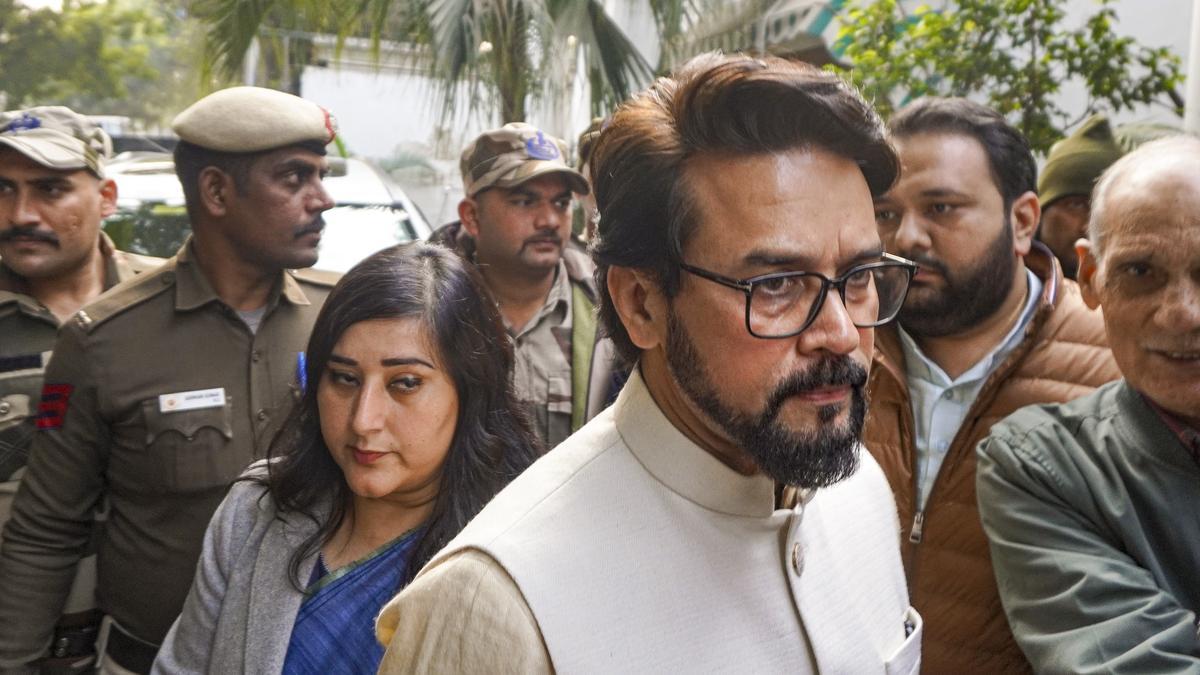
Day 8 at The Music Academy witnessed a packed audience for the second panel discussion of the Academic Sessions, centered on the intriguing topic, ‘Lakshana and Lakshya: A Contested Relationship.’ The panel featured insightful contributions from Sriranjani Santhanagopalan, G. Ravikiran, and Bharat Sundar, who explored the intricate relationship between lakshana (the grammar and structure of music) and lakshya (its artistic expression and practice).
Sriranjani opened the discussion by speaking about the three states of a musician, the first one being the state of consumption, the second one being in a state of practice and lastly, the state of flow, which is hopefully unaffected by the first two. Sriranjani emphasised that lakshana encompasses elements such as patanthara (the lineage of musical tradition), classes with gurus, and recordings. She brought in an analogy, comparing the interplay of lakshana and lakshya to understanding a mountain, she explained that while one can appreciate the beauty of a mountain without special knowledge, climbing it requires detailed information — akin to mastering lakshana to effectively engage with lakshya. For her, lakshya represents the creative expression of an artiste at a given moment, shaped by socio-economic factors, voice texture, and musicianship.
G. Ravikiran contributed with historical and theoretical insights, illustrating his points with Tyagaraja compositions such as ‘Vidulaku mrokkeda’. He noted that Tyagaraja mentioned in the charanam that those who have ‘Sangita shastra Ggyanamu’ (knowledge of musicology) are close to his heart . He brought out how the relationship between lakshya and lakshana is cyclical and referred to documented raga lakshana discussions that have happened atthe Music Academy in the past, mentioned in its journals, where debates about distinctions between ragas such as Dilipakam and Karaharapriya or the discussions about the phrases of Manirangu highlight the dynamic interplay between lakshana and lakshya. He underscored that lakshana is a living entity, constantly engaging with the lakshya of its time.
Bharat Sundar brought a personal experiential perspective, reflecting on his journey as a musician. He attributed his foundational learning to his gurus and later expanded his understanding of both lakshana and lakshya through manodharma (creative improvisation), studying compositions, attending lectures, discussions with musician-friends, and listening to recordings. For Bharat, the dynamic interaction between lakshana and lakshya is central to the growth of a musician, acknowledging both theoretical study and creative freedom with equal weight.
Sriranjani illustrated the lakshya through Semmangudi Srinivasa Iyer’s rendition of ‘Marubalka’ in Sriranjani, where he incorporated subtle touches of panchamam and antara gandharam. Similarly, she highlighted M.D. Ramanathan’s interpretation of the Narayanagowla Varnam, where the phrase ‘ngrsn’ featured the sadharana gandharam. Sriranjani emphasised that our trust in a musician’s creativity shapes how we perceive the lakshya and lakshana. She lamented the loss of pracheena (traditional) sangathis in modern renditions, pointing out how arohana and avarohana sometimes dilute ancient phrases. For example, in the Begada varnam, the original phrase ‘sndss’ has been altered to ‘sndns’.
Ravikiran explained that the growing emphasis on manodharma and the sheer volume of concerts affect the lakshana of ragas. He pointed out that certain phrases, such as dns in a Begada raga alapana, is not consciously sung, despite being included in compositions. He also reinforced this with an example from the ‘Varaveena’ geetham, where the line ‘sarasija jana janani’ originally had the prayoga ‘sggg’, which has now been changed to ‘srggg’. Sriranjani humorously quoted a senior musician’s remark that revised editions of compositions should be labelled “tampered editions.”
The discussion then turned to how ‘amplification’ influences lakshya and lakshana. Older musicians, without microphones, often sang in higher octaves to project sound. Based on what they sang, the lakshana would be created.
Ravikiran noted cases where ragas possess lakshana but lack lakshya, and vice versa, and cited instances where both were absent. He critiqued the adaptation of the song ‘Parandamavati’ in Dharmavati, arguing that retrofitting it into Dharmavati compromised the original intent. Bharat raised an important question about how musicians approach the mind space of a raga. He cited Ramnad Krishnan’s rendition of Mukhari, where unconventional phrases still preserved the raga’s essence. He also examined how voice production affects lakshya, as the same gamaka can sound different across vocal textures.
Sriranjani emphasised the need for musicians to shift from conscious to unconscious states while improvising, urging them to listen to their inner calling and develop their own lakshya. Ravikiran argued against rigidly adhering to printed lakshana rules, warning that the overdependence on lakshya risks homogenising ragas. He cited Manji as an example, where its distinct identity is lost due its similarity with Bhairavi.
During the Q&A session, concerns were raised about overthinking ragas, which could stifle creativity. Vidwan Shashank pointed out that the gamakas produced by instruments differ based on their structural capabilities, influencing the lakshya.
T.M. Krishna concluded with a philosophical perspective, defining lakshana as an organised framework that lends logical structure to a raga while lakshya represents its intuitive essence. He highlighted the need to question lakshana to better understand lakshya. Drawing parallels to Archimedes’ “Eureka” moment, Krishna described the exploration of lakshana as a flow of discovery. He also reflected on the socio-cultural factors influencing lakshana, noting historical biases due to predominantly male scholars, and celebrated the rise of women scholars reshaping contemporary interpretations.
Published – December 25, 2024 12:01 pm IST
Friday Review
/
Chennai Margazhi Season










